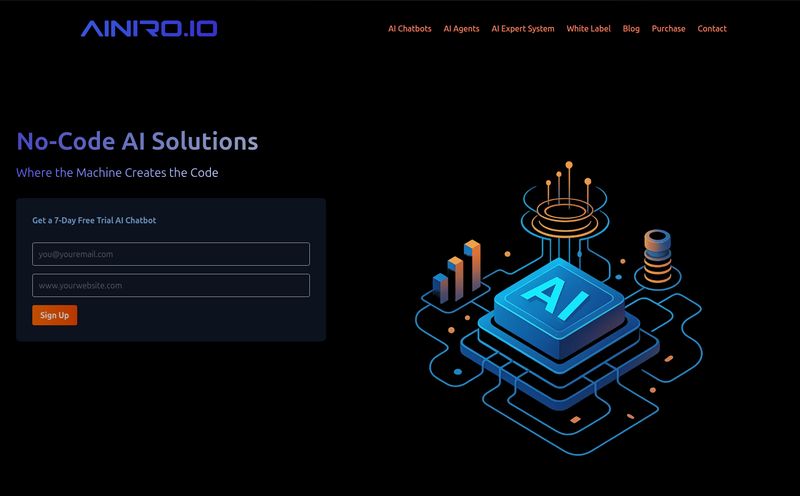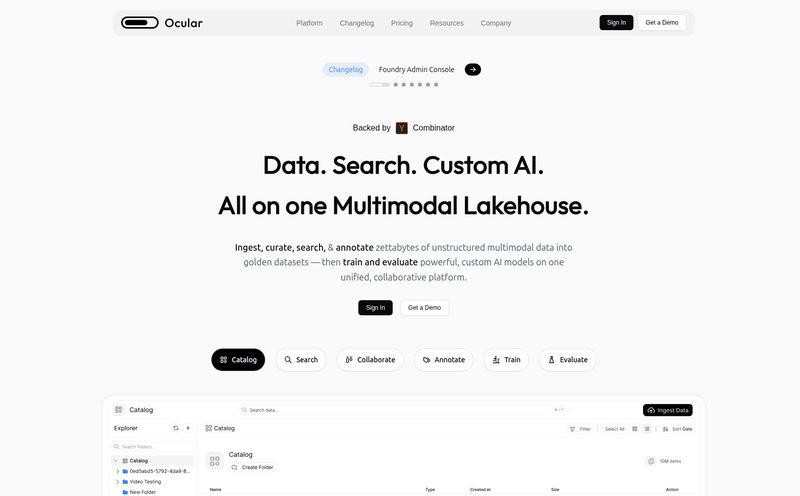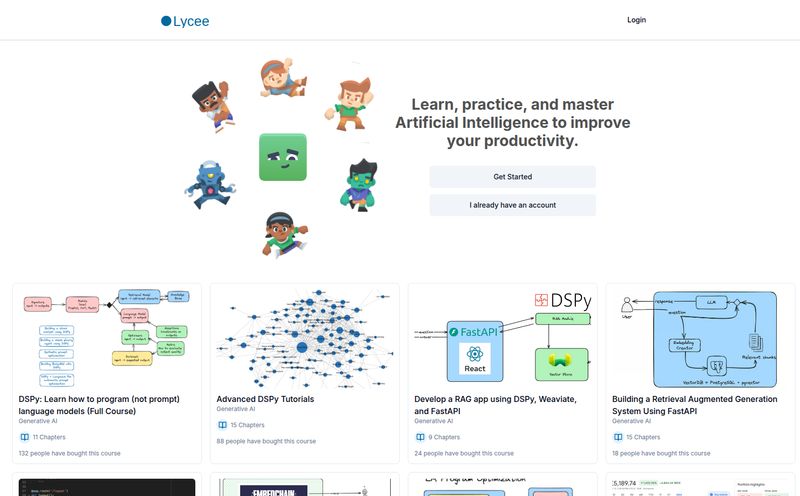How many of us in the engineering and data science world have a sad little folder on our desktops, overflowing with PDFs? You know the one. It's filled with groundbreaking papers from arXiv, NeurIPS, and ICML. Papers with titles that promise to revolutionize object detection or create impossibly realistic generative art. We download them, full of ambition, swearing we'll implement that new algorithm 'this weekend'.
Then the weekend comes. And goes. The paper, with its dense mathematics and vague 'methodology' section, stares back at you. Mocking you. That brilliant idea remains trapped in the PDF, a victim of the massive chasm between academic theory and practical, runnable code.
I've always believed the biggest bottleneck in AI innovation isn't a lack of ideas, but a lack of implementation hours. So when I stumbled upon a new tool called Cerelyze, my curiosity was definitely piqued. The promise? To automatically convert research paper methods into code. A bold, almost audacious claim. Could this be the bridge over that chasm we've all been waiting for?
What Exactly is Cerelyze Supposed to Do?
The core concept is deceptively simple, yet incredibly powerful. Cerelyze aims to be a universal translator, but instead of translating French to English, it translates academic jargon into Python (or one assumes Python, given the industry). You feed it a research paper, and it analyzes the methodology, the algorithms, the whole shebang, and spits out functional code on the other side.
This isn't just about saving time. It's about accessibility. It’s about letting engineers, who might be brilliant coders but not PhD-level mathematicians, leverage the absolute latest in machine learning research without spending a month deciphering equations. It’s a pretty compelling idea.
A First Look at the Cerelyze Platform
So, brimming with excitement, I headed over to their website. And I was greeted with... well, not much. Just a simple, clean page with the five-word sentence:
Building something cool, brb..
Normally, that might be a red flag. But in the fast-moving world of AI startups, it's also a dog whistle. It says, 'We're new, we're probably heads-down coding, and if you're here now, you're an early adopter.' It’s intriguing, not off-putting. It feels like getting a tip on a band before they get famous. While the front door is still being built, they've at least given us a peek at the floor plan through their pricing structure.

Visit Cerelyze
Breaking Down the Cerelyze Pricing Tiers
The pricing page gives us the most concrete information about what Cerelyze is becoming. It’s a classic two-tier Freemium model, which tells you a lot about their strategy.
Here's the breakdown:
| Tier | Key Features | My Take |
|---|---|---|
| Free Trial | 500MB max dataset size; Cannot be used for commercial purposes. | This is your 'kick the tires' plan. 500MB is enough to test the functionality with a standard dataset, but you won't be doing any heavy lifting. The non-commercial clause is standard. It’s for satisfying your curiosity. |
| Enterprise Tier | Connect dataset via S3, GCP, Azure; More accurate models; Commercial usage license; Dedicated support. | This is the real deal. Cloud data integration is non-negotiable for any serious MLOps workflow. 'More accurate models' is a fascinating and telling feature. It implies the conversion process itself is model-based and that they have a premium, more powerful version. The price is 'Talk to us', which usually means 'if you have to ask, you can't afford it' — or more realistically, it's value-based pricing for teams. |
The Potential Upsides: Why I'm Genuinely Excited
Even in its pre-launch phase, the potential here is massive. Think about the engineering hours burned on just trying to replicate a paper's results. We're talking weeks, sometimes months. If an ML engineer costs a company, say, $150,000 a year, saving them two weeks of work has already paid for a hefty software license. The ROI is obvious.
But it's more than just money. This could drastically shorten the cycle from discovery to product. An idea published in May could be a feature in your app by July, not next year. This is how you get a real competitive edge. It could help finally, truly bridge the infamous gap between the academic ivory tower and the industrial trenches where things actually get built.
The Reality Check: Potential Hurdles for Cerelyze
Alright, let's put the hype aside for a moment. This is an incredibly difficult problem to solve. Anyone who's read a few research papers knows they aren't exactly standardized instruction manuals. They're often filled with implicit assumptions, novel notation, and sometimes, just plain ambiguity. The promise of supporting any paper is a tall order.
The big, million-dollar question is how well Cerelyze's conversion model handles the messy reality of academic writing. How does it interpret a poorly labeled diagram or a method described in prose rather than pseudocode? This is where the tool will either become a gimmick or a genuine game-changer. The fact that the Enterprise tier offers "more accurate models" suggests they are acutely aware of this challenge. Its still early days, so we have to give them the benefit of the doubt.
Who is Cerelyze Actually For?
I can see a few key groups getting really excited about this:
- The Scrappy Startup ML Engineer: You're a small team, you need to move fast and punch above your weight. You don't have an R&D department; you are the R&D department. This could be your secret weapon.
- The Corporate R&D Team: You're tasked with 'innovation' and evaluating new technologies. Cerelyze could be a powerful tool for rapidly prototyping and validating emerging research before committing serious resources.
- The Grad Student/Postdoc: You need to build on the work of others, and fast. Instead of spending a month replicating a baseline model, you could do it in an afternoon and spend your time on your actual novel contribution.
Cerelyze vs. The Alternatives
Right now, what do we do instead? The main alternative is, of course, manual implementation—just you, a coffee, and a PDF. The other godsend is an author-provided GitHub repo. Sites like Papers with Code have done a fantastic job of linking papers to official implementations. But what about the 90% of papers that don't have clean, maintained codebases? That's the void Cerelyze is trying to fill. It's not competing with GitHub Copilot, which helps you write code line-by-line; it's a step before that, translating the entire concept into a coded starting point.
My Final Thoughts (For Now)
Cerelyze is a moonshot. It's a bold, ambitious project tackling a problem that many of us have just accepted as 'part of the job.' If they can truly deliver on their promise, it won't just be a useful tool; it will fundamentally change the workflow of AI development. If they can't, it will be another interesting but failed experiment.
For now, I'm in the 'cautiously optimistic' camp. I've bookmarked their site, and you can bet I'll be back to kick the tires with that Free Trial the second it goes live. The promise is just too tantalizing to ignore.
Frequently Asked Questions about Cerelyze
- Is Cerelyze free to use?
- It appears so. They offer a Free Trial with a 500MB dataset limit and a non-commercial use license. For professional use, you'll need the paid Enterprise Tier.
- What programming language does Cerelyze generate?
- The website doesn't specify yet, but given its focus on AI and machine learning, the safe bet is on Python with popular libraries like PyTorch or TensorFlow.
- How does Cerelyze handle complex diagrams or formulas in papers?
- This is the key technical challenge. The success of the platform will depend on how its underlying models can parse both structured (equations) and unstructured (prose, diagrams) information from a paper.
- Can I use Cerelyze for my company's commercial product?
- Not with the Free Trial. The pricing page clearly states you need the Enterprise Tier for a commercial usage license.
- When will Cerelyze be fully launched?
- There's no public launch date. The message "Building something cool, brb.." suggests it's actively in development and could launch anytime.
Reference and Sources
- Cerelyze Official Website: Link would go here, but the site is currently minimal.
- arXiv.org: The open-access archive for scholarly articles in physics, mathematics, computer science, and more.
- Papers with Code: A community-driven resource for finding and exploring research papers with their corresponding code.
- NeurIPS (Conference on Neural Information Processing Systems): A major annual machine learning conference.



